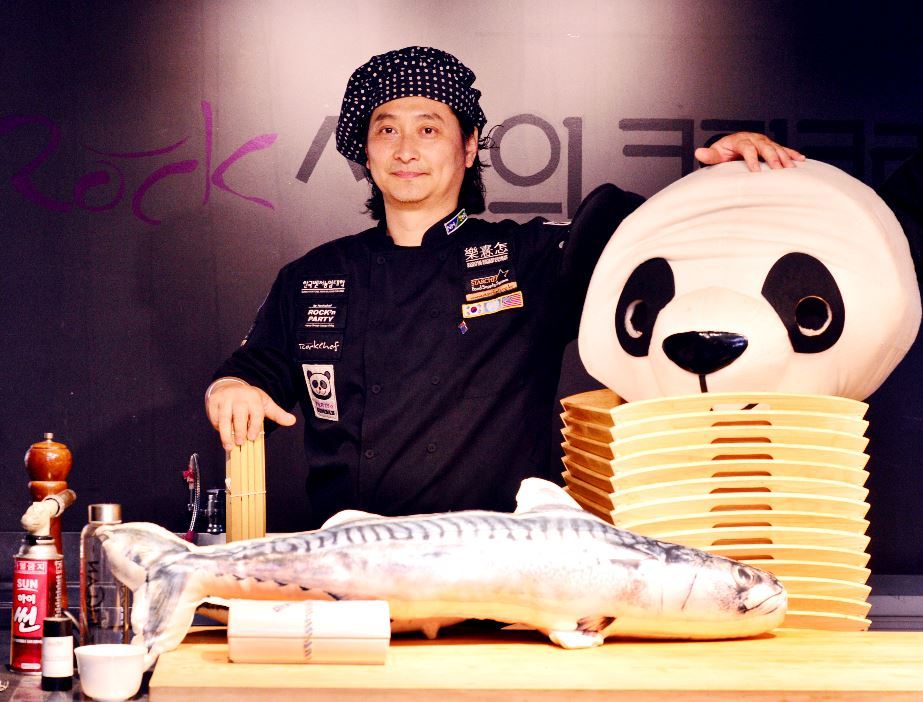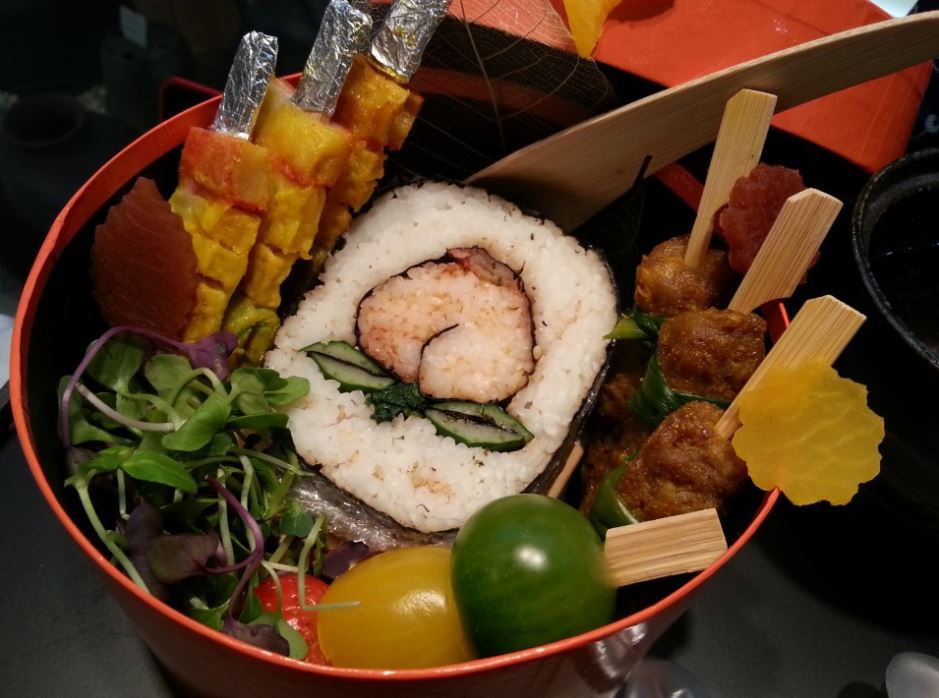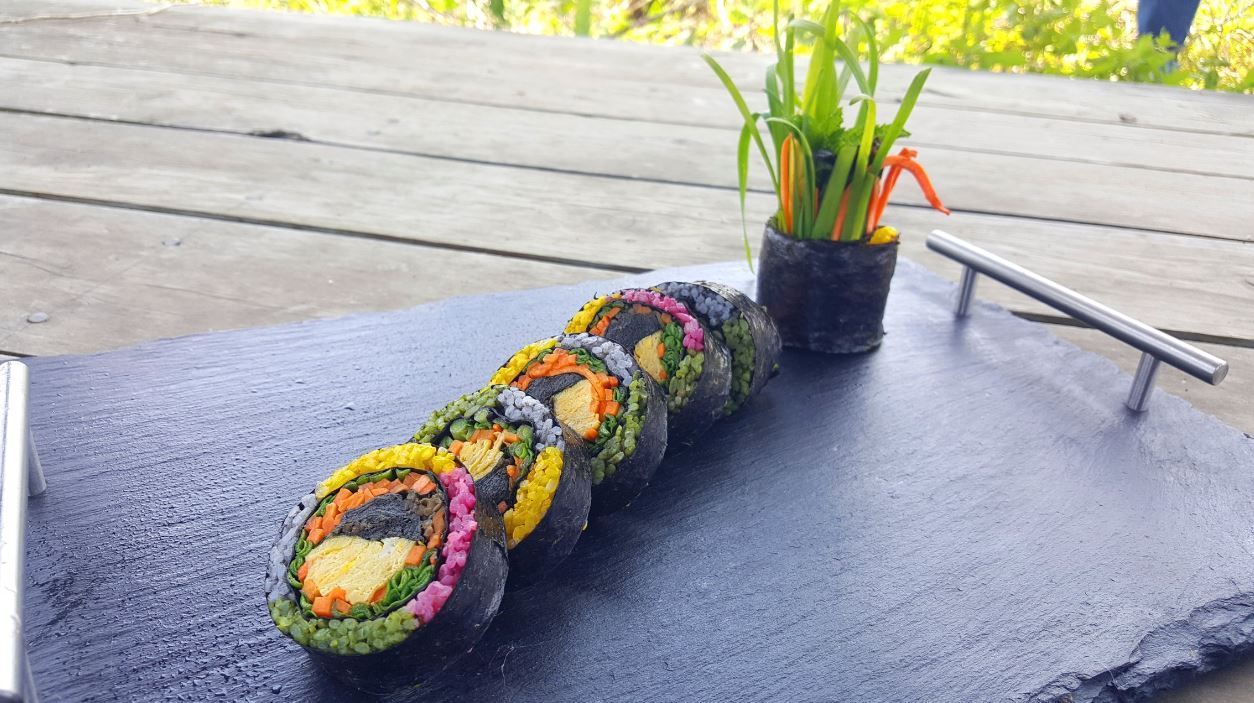[Herald Interview] Chef puts faith in gimbap
Kim Rock-hun bent on giving Korea’s beloved street food a gourmet makeover
By Lee Sun-youngPublished : May 24, 2019 - 10:13
For chef Kim Rock-hun, gimbap is the perfect meal for the times.
A roll of rice, vegetables and other ingredients wrapped tightly in a seaweed laver sheet, gimbap is tasty and healthy. Typically served in bite-sized slices, it is convenient to pack and eat on the move.
“It is ‘slow fast food,’ filled with healthy ingredients. Can there be a better meal?” Kim, 49, said during an interview at his cooking studio in Dogok-dong, southern Seoul.
A roll of rice, vegetables and other ingredients wrapped tightly in a seaweed laver sheet, gimbap is tasty and healthy. Typically served in bite-sized slices, it is convenient to pack and eat on the move.
“It is ‘slow fast food,’ filled with healthy ingredients. Can there be a better meal?” Kim, 49, said during an interview at his cooking studio in Dogok-dong, southern Seoul.

The only problem, according to him, is that not many chefs, restaurateurs or customers fully recognize its value yet.
Gimbap is, to most people, a quick snack sold at street stalls, convenience stores and cheap eateries for around 2,000 won ($1.70). People are used to the good but unimaginative combination of rice, seaweed and vegetables. Even those with a “premium” tag don’t cost more than 7,000 won.
“If you try gourmet gimbap and you will understand there’s another level in gimbap,” he said.
The chef says he has created thousands of variations to give the timeless lunch menu item a new flavor, look and appeal.
His culinary experiments covered almost every ingredient available to him, from ginseong, or dried fish, to pickled Korean melon. Some were more difficult than others to incorporate into the rolled dish, he said.
“My big idea was to create gimbap variations that represent each region of our country, using locally grown ingredients,” he said.

He also tried to promote gimbap on the global stage. He used gimmicky approaches depending on the audience, sometimes making super-sized gimbap at 4-5 meters long or making a tiny one that resembles a panda.
It took him years of practice to master the skill of making a giant gimbap without tearing the seaweed sheet.
“The first major international event where I had the chance to showcase my skill was Fitur 2016, the International Tourism Fair in Spain. I got cold feet,” he recalled.
To make the rice roll 4-5 meters long, he glued regular-sized seaweed sheets -- about 20 centimeters long -- and created a long sheet of that length, using grains of steamed rice and some water. That was not an easy thing to do, but the hardest part was to roll it up with rice and ingredients.
“You should be really careful rolling just bit by bit from one end to the other end so as not to tear the seaweed sheet,” he said.
Another tactic was adding design elements to the dish. His signature design is a panda’s face, with two tiny ears made with rice and seaweed. One of his latest designs features pink rice, seaweed and cucumber ridges that create a peach shape inside a square-shaped gimbap.

Despite such efforts and Korean cuisine’s popularity overseas, he rarely sees chefs paying attention to gimbap -- at least not in the same way that he does.
He acknowledged that some restaurants overseas serve gimbap, but their versions are usually stripped-down rolls, served on not-so-fancy plates.
“There is no new approach,” he said.
Most foreigners who have watched his cooking show expressed great interest in gimbab as “creative food” that can be deconstructed and reborn with new flavors and looks.
With the finest ingredients, playful flavors and creative presentation, gimbap could introduce a whole new fine-dining experience, Kim stressed.
The chef’s faith in gimbap comes from his experience in the late 1990s working at famous Japanese restaurants in the UK and Japan. At the time, sushi was having a big moment in the global culinary scene.
Kim, then an electronic engineering major at a university, was a world traveler on an extremely tight budget. He somehow got a job at a Japanese restaurant in downtown London, despite having no professional cooking experience.
He discovered that he had a hidden talent in the kitchen, and Westerners loved sushi rolls, which in his opinion, were no match for gimbap.
“Watching customers crave sushi rolls, I thought gimbap could be big on the global scene someday -- even bigger than sushi,” he said.
The chef believes gimbap is delicious even with very minimal ingredients. His personal favorite is rice and a chunk of seaweed marinated in soy sauce, wrapped in crisply roasted nori sheet.
“It’s a killer pairing -- roasted nori seaweed and plain steamed rice, and just a bit of seasoning. Add a few fine ingredients and it is perfection,” he said.
The dedication to gimbap has earned the self-taught chef fame and recognition.
He had the honor of carrying the torch for the 2018 PyeongChang Winter Games, and until recently, he ran cooking classes at Cheong Wa Dae Sarangchae, a visitor’s center in front of the presidential residence.
Currently, he is preparing for a new stint as supervisor of a local food promotion center, slated to open in June in the city of Sejong. The facility will have two restaurants and a cooking institute, all designed to promote the local food movement.
That is something that he has tried with his gimbap creations, even before the global fad took off in Korea.
By Lee Sun-young (milaya@heraldcorp.com)







![[KH Explains] How should Korea adjust its trade defenses against Chinese EVs?](http://res.heraldm.com/phpwas/restmb_idxmake.php?idx=644&simg=/content/image/2024/04/15/20240415050562_0.jpg&u=20240415144419)











![[Today’s K-pop] Stray Kids to return soon: report](http://res.heraldm.com/phpwas/restmb_idxmake.php?idx=642&simg=/content/image/2024/04/16/20240416050713_0.jpg&u=)